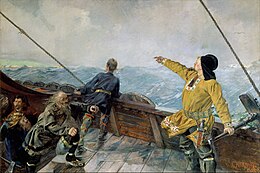
| Part of a series on the |
| Norse colonization of North America |
|---|
 Leiv Eirikson Discovering America, 1893 painting by Christian Krohg Leiv Eirikson Discovering America, 1893 painting by Christian Krohg |
| Places |
| Alleged artifacts |
| Explorers |
| Literature |
| Researchers |
Flateyjarbók (Icelandic pronunciation: [ˈflaːtˌeiːjarˌpouːk]; "Book of Flatey") is an important medieval Icelandic manuscript. It is also known as GkS 1005 fol. and by the Latin name Codex Flateyensis. It was commissioned by Jón Hákonarson and produced by the priests and scribes Jón Þórðarson and Magnús Þórhallsson.
Description
Flateyjarbók is the largest medieval Icelandic manuscript, comprising 225 written and illustrated vellum leaves. It contains mostly sagas of the Norse kings as found in the Heimskringla, specifically the sagas about Olaf Tryggvason, St. Olaf, Sverre, Hákon the Old, Magnus the Good, and Harald Hardrada. But they appear here expanded with additional material not found elsewhere (some of it being very old) along with other unique differences. Most—but not all—of the additional material is placed within the royal sagas, sometimes interlaced. Additionally, the manuscript contains the only copy of the eddic poem Hyndluljóð, a unique set of annals from creation to 1394, and many short tales not otherwise preserved such as Nornagests þáttr ("the Story of Norna Gest").
Especially important is the Grœnlendinga saga ("History of the Greenlanders"), giving an account of the Vinland colony with some differences from the account contained in Eiríks saga rauða ("History of Eirík the Red"). Here also are preserved the only Icelandic versions of the Orkneyinga saga ("History of the Orkney Islanders") and Færeyinga saga ("History of the Faroe Islanders").
History
From internal evidence the book was being written in 1387 and was completed in 1394 or very soon after. The first page states that its owner is "Jonn Hakonar son" and that the book was scribed by two priests. One of them, "Jon prestr Þórðar son", scribed the contents from the tale of Eirík the Traveller down to the end of the two Olaf sagas and the other, "Magnús prestr Thorhallz sun", scribed the earlier and later material and also drew the illustrations.
Further material was inserted towards the end of the 15th century.
The manuscript first received special attention by the learned in 1651 when Bishop Brynjólfur Sveinsson of Skálholt, with the permission of King Frederick III of Denmark, requested all folk of Iceland who owned old manuscripts to turn them over to the Danish king, providing either the original or a copy, either as a gift or for a price. Jon Finnsson, who resided on Flatey ('Flat Island') in the fjord of Breiðafjörður on the northwest coast of Iceland, was then the owner of the book which was already known as the Flateyjarbók. At first Jon refused to release his precious heirloom, the biggest and best book in all of Iceland, and he continued to refuse even when Bishop Brynjólfur paid him a personal visit and offered him five hundreds of land. Jon only changed his mind and bestowed the book on the bishop just as the bishop was leaving the region.
The manuscript was given as a present from Bishop Brynjólfur to King Frederick III in 1656, and placed in the Royal Library of Copenhagen. In 1662, the bishop presented the king with a second medieval manuscript, the Codex Regius (Konungsbók eddukvæða). It and Flateyjarbók survived the Copenhagen Fire of 1728 and the Second Battle of Copenhagen in 1807 and were eventually repatriated to Iceland in 1971 as Icelandic national treasures. They are preserved and studied by the Árni Magnússon Institute for Icelandic Studies.
Contents
Flateyjarbók consists of the following texts:
Gallery
Illustrations-
 Harald Fairhair receives Norway out of his father Halfdan the Black's hands.
Harald Fairhair receives Norway out of his father Halfdan the Black's hands.
Modern translations
Flateyjarbók is currently being translated into English by the Saga Heritage Foundation of Norway. The translator is Alison Finlay, professor of Medieval English and Icelandic Literature at Birkbeck, University of London. A Norwegian edition, translated by Edvard Eikill and comprising six volumes, was completed in 2019.
Notes
- Ashman Rowe, Elizabeth (2005). The Development of Flateyjarbók: Iceland and the Norwegian Dynastic Crisis of 1389. The Viking Collection: Studies in Northern civilization. Vol. 15. Gylling: The University Press of Southern Denmark. p. 11. ISBN 87-7838-927-5.
- Such as Nornagests þáttr ("the Story of Norna-Gest"), Styrbjarnar þáttr Svíakappa ("Tale of Styrbjörn the Swedish Champion"), Hróa þáttr heimska ("The Tale of Roi the Fool") and Völsa þáttr ("the Tale of the Phallos").
- "Flateyjarbók: The Chronicles of the Viking Kings". The Saga Heritage Foundation. Retrieved 2 November 2024.
- "Storslått sagaverk fullført". Stavanger Aftenblad (in Norwegian). 15 December 2019. Retrieved 21 April 2021.
References
- Rowe, Elizabeth Ashman (2005). The Development of Flateyjarbók. Odense: The University Press of Southern Denmark.
- Guðbrandur Vigfússon and Carl Rikard Unger, (ed.) (1860–1868). Flateyjarbok: En samling af Norske Konge-saegar, 3 Vols. Christiania : P. T. Mallings forlagsboghandel.
- Anderson, Rasmus B. (trans. ed.) (1906). The Flatey Book and Recently Discovered Vatican Manuscripts Concerning America as Early as the Tenth Century. London: The Norroena Society. (Facsimiles of Icelandic text, Icelandic transcription, Danish translation, English translation of Vinland material and related material only.)
Editions and translations
Editions
- Flateyjarbók, ed. by Guðbrandur Vigfússon and C.R. Unger: volume 1 (1860), volume 2 (1862), volume 3 (1868), also digitised at Heimskringla.no (diplomatic edition)
- Flateyjarbók, , 4 vols (Akranes: Flateyjarútgáfan, 1944–45) (normalised Old Norse spelling)
Translations
- Waggoner, Ben (2010). Sagas of Giants and Heroes. New Haven, CT: Troth Publications. ISBN 978-0578059334. (Tale of Halfdan the Black, pp. 1–10; Tale of Hauk High-Breeches, pp. 11–20)
- Flatøybok (in Norwegian). Translated by Edvard Eiki. Stavanger, Norway: Saga Bok. 2014–2019. ISBN 978-82-91640-99-0.
External links
- GKS 1005 fol., Digitized manuscript, handrit.is
- Flateyjarbok translation project, The Saga Heritage Foundation
- Elizabeth Ashman Rowe, "Cultural Paternity in the Flateyjarbók Óláfs saga Tryggvasonar," Alvíssmál 8 (1998): 3–28.